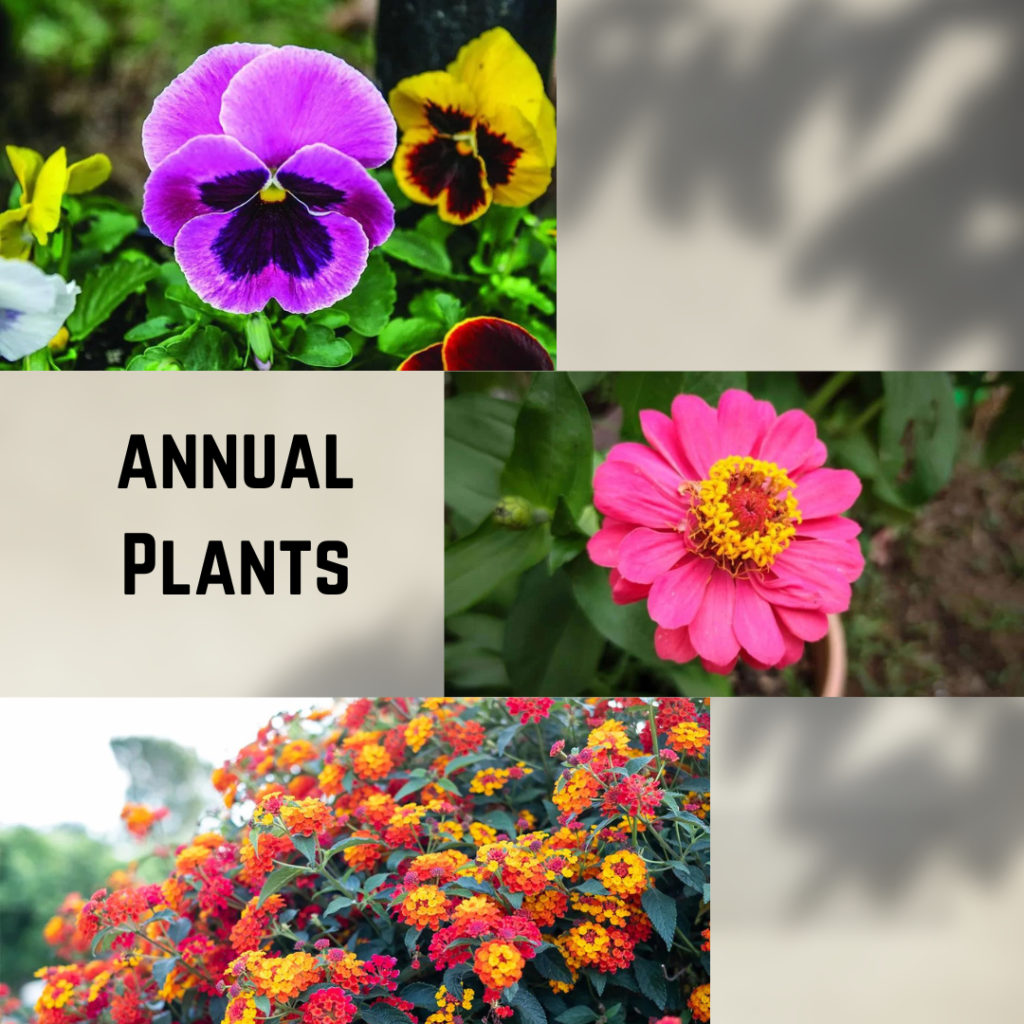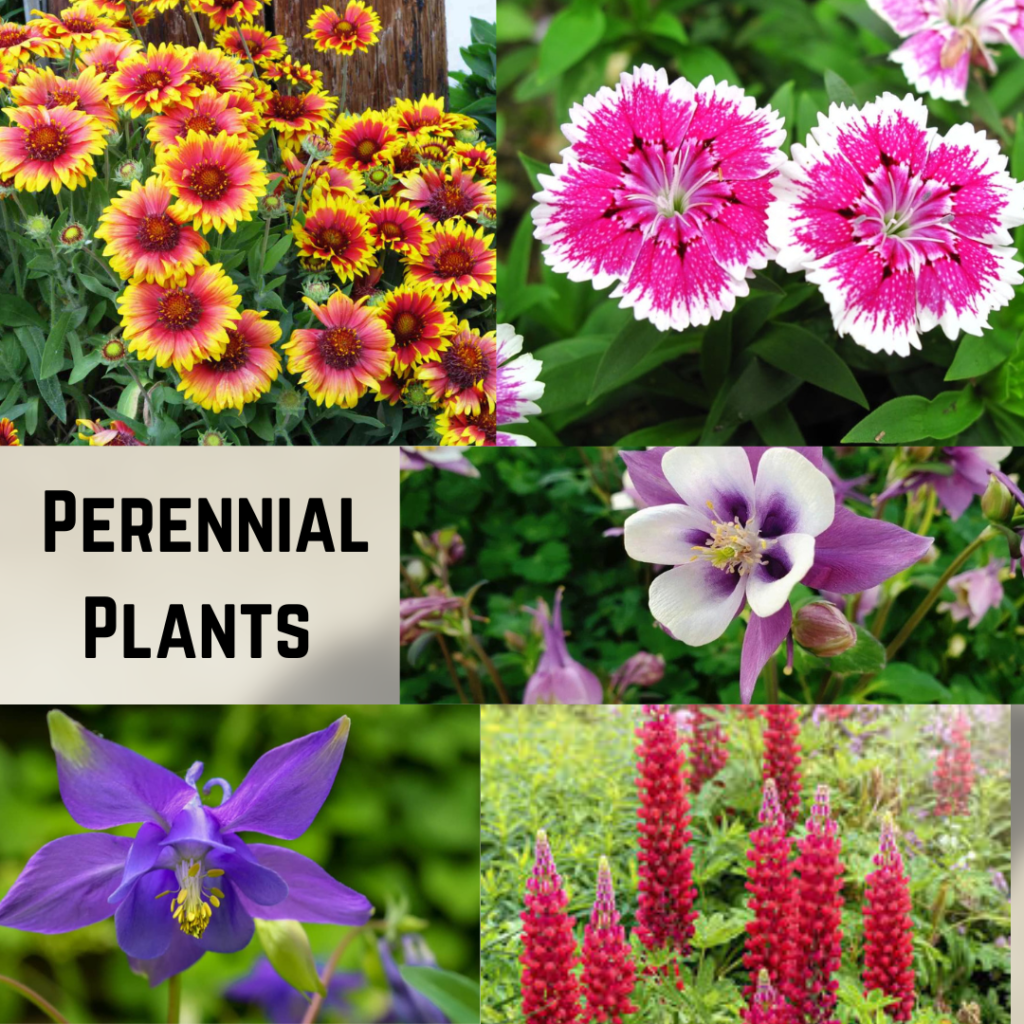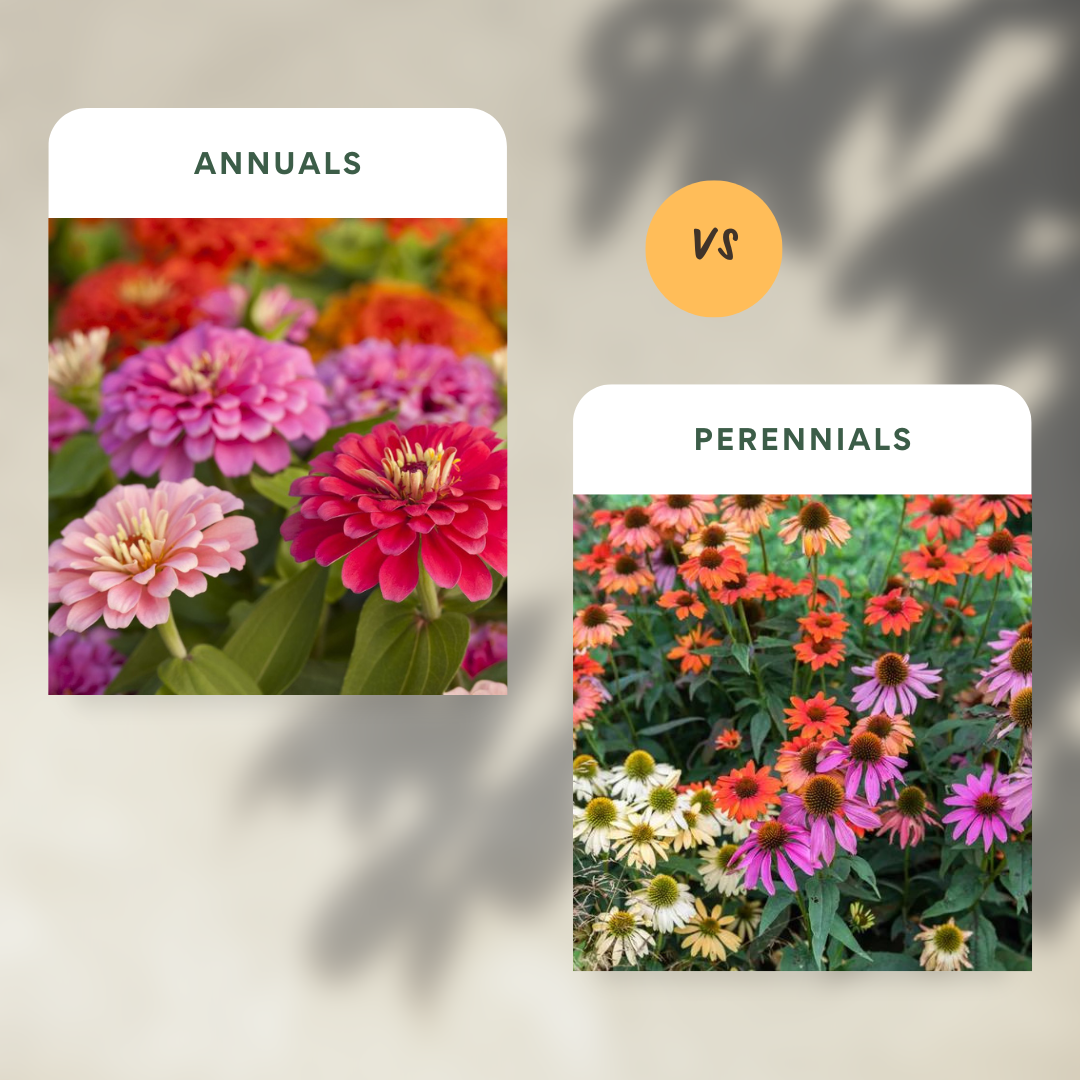When planning a garden, one of the key decisions is whether to use annual or perennial plants. Both types have distinct characteristics and benefits that can enhance your garden in different ways. Understanding the differences between annuals vs perennials is crucial for creating a beautiful, thriving garden that meets your goals and preferences.
Perennials
Definition
A plant that lives more than two years, distinguishing it from annuals and biennials.
Prevalence
Approximately 94% of plant species are perennials.
Herbaceous Perennials
These plants grow and bloom over the spring and summer, die back in autumn and winter, and return in the spring from their rootstock.
Climate Impact
A perennial in its native habitat may be treated as an annual in different climates due to survival challenges of above-ground biomass.
Evergreen Perennials
A class of perennials without woody stems that retain leaves all year, like Bergenia.
Subshrubs
Plants with a vestigial woody structure in winter, such as Penstemon.
Symbol
The symbol for perennial plants is derived from Species Plantarum by Linnaeus, also representing the planet Jupiter.
Annuals
Life Cycle
Completes life cycle from germination to seed production in one growing season.
Global Prevalence
Only 6% of all plant species and 15% of herbaceous plants are annuals
Evolution
Annuals have independently emerged in over 120 plant families
What are Annuals?
Annuals are plants that complete their entire life cycle – from seed to flower to seed – in one growing season. They germinate, grow, bloom, produce seeds, and die all within a single year. Some key characteristics of annuals include:
- Rapid growth and prolific blooming
- Typically showy, colorful flowers
- Need to be replanted each year
- Provide instant color and impact
Benefits of planting annuals:
- Flexibility to change color schemes and designs yearly
- Long blooming period (often all season)
- Great for filling in gaps in perennial gardens
- Allow for experimentation with different plants
Types of Annuals
Annuals can be categorized into three main types based on their tolerance to temperature:
Hardy or Cool-Season Annuals: These can withstand light frost and thrive in cooler temperatures.
Examples include forget-me-nots and larkspur.
Tender or Warm-Season Annuals: These require warm temperatures to grow and are sensitive to frost. Examples include marigolds and petunias.
Half-Hardy Annuals: These can tolerate a range of temperatures, including cooler weather at the beginning or end of the growing season.
Drawbacks of Planting Annuals
Higher Maintenance: Annuals often require more frequent watering, fertilizing, and deadheading to maintain their blooms throughout the season.
Short Lifespan: Since they complete their life cycle in one season, they need to be replanted every year, which can be time-consuming and costly in the long run.
Sensitivity to Weather: Many annuals are not frost-tolerant and can be damaged by cold weather, limiting their growing season in cooler climates.
What are Perennials?
Perennials are plants that live for more than two years, returning year after year. Their roots survive underground through winter, with new growth emerging in spring. Key characteristics include:
- Live for multiple growing seasons (3+ years)
- Slower initial growth but become established over time
- May have a shorter blooming period than annuals
- Roots and woody growth persist year-round
Benefits of planting perennials:
- Lower maintenance once established
- Cost-effective long-term as replanting is not needed yearly
- Provide structure and consistency to garden design
- Many attract pollinators and beneficial insects
Types of Perennial Plants:
Herbaceous perennials – Plants with non-woody stems that die back to the ground each winter and regrow in spring. Examples include daylilies, hostas, and coneflowers.
Woody perennials – Plants with persistent above-ground woody stems, including trees, shrubs, and vines. Examples include maple trees, lilac bushes, and climbing roses.
Evergreen perennials – Plants that retain their foliage year-round. Examples include pine trees, boxwood shrubs, and some ferns.
Deciduous perennials – Plants that lose their leaves seasonally. Examples include oak trees, hydrangeas, and peonies.
Monocarpic perennials – Plants that flower and set seed once, then die. Examples include agave and some bamboo species.
Drawbacks of Perennial Plants:
- Higher initial cost compared to annuals.
- Slower to establish and reach full size, often taking 2-3 years.
- Many have shorter blooming periods than annuals.
- Some require regular maintenance like dividing and pruning.
- Can be more susceptible to pest and disease buildup since they aren’t rotated annually.
- Some aggressive spreaders can become invasive in the garden.
- Less flexibility to change garden design yearly.
- May have periods of dormancy or less attractive appearance.
- Some perennials have strong flavors that make them less palatable as edibles.
- Difficult to rotate crops with perennial vegetables, which can lead to nutrient depletion in soil.
Comparing Lifespans
The main difference between annuals and perennials is their lifespan:
Annuals: Complete life cycle in one growing season (3-4 months)
Perennials: Live for 3+ years, going dormant in winter and re-emerging in spring
This difference in lifespan impacts many aspects of garden planning and maintenance.
Cost Implications
Initial costs:
Annuals: Lower upfront cost but need to be repurchased yearly
Perennials: Higher initial investment but last for multiple years
Long-term costs:
Annuals: Higher cumulative cost due to yearly replanting
Perennials: More cost-effective over time once established
Maintenance costs may be higher for annuals due to more frequent watering and fertilizing needs.
Maintenance and Care
Annuals:
Require more frequent watering and fertilizing
Need deadheading to promote continuous blooming
Must be replanted each year
Perennials:
Lower water needs once established
May need dividing every few years
Require pruning and cleanup of dead foliage
Seasonal Considerations
Annuals:
Best planted after last frost date in spring
Provide color through summer and fall until first frost
Allow for seasonal color changes
Perennials:
Can be planted in spring or fall
Bloom times vary by species (spring, summer, or fall)
Provide year-round structure even when not blooming
Aesthetic and Design
Annuals offer flexibility in color schemes and allow for yearly changes to garden design. They’re great for container gardens and filling gaps between perennials.
Perennials provide consistency and structure to garden design. They’re ideal for creating long-term landscape themes and naturalistic plantings.
Integration Strategies
Many gardeners find success in combining both annuals and perennials:
- Use perennials as the backbone of the garden
- Fill in with annuals for continuous color
- Plant annuals in containers among perennial beds
- Use annuals to experiment with color schemes before committing to perennials.
Environmental Impact
- Perennials are generally considered more sustainable:
- Require less frequent replanting, reducing plastic pot waste
- Established root systems help prevent soil erosion
- Many native perennials support local ecosystems
- However, both types can be grown sustainably with proper practices.
Popular Annual Plants

Petunias – These versatile flowers come in many colors and are easy to grow. They bloom profusely all season long and work well in beds, containers, and hanging baskets.
Marigolds – Known for their bright yellow and orange flowers, marigolds are hardy, low-maintenance annuals that bloom throughout summer and fall.
Zinnias – These colorful flowers are easy to grow from seed and bloom abundantly in summer and fall. They come in a wide range of colors and sizes.
Sunflowers – With their large, cheerful blooms, sunflowers are popular annuals that are easy to grow from seed. They attract pollinators and birds.
Cosmos – These daisy-like flowers bloom prolifically and come in shades of pink, white, and red. They’re great for cutting gardens.
Impatiens – Perfect for shady areas, impatiens produce abundant flowers in various colors all season long.
Calibrachoa (Million Bells) – These small petunia-like flowers bloom profusely in hanging baskets and containers. They come in many vibrant colors.
Angelonia – Also called summer snapdragon, these heat-tolerant plants produce spikes of flowers in purple, pink, and white.
Begonias – With their waxy leaves and colorful flowers, begonias are popular for shady spots and containers.
Salvia – These spiky flowers come in shades of red, purple, and blue. They attract hummingbirds and butterflies.
Lantana – Heat and drought-tolerant, lantana produces clusters of small flowers in various colors. It’s great for containers and attracts butterflies.
Sweet Alyssum – This low-growing plant produces masses of tiny, fragrant flowers, making it perfect for edging and rock gardens.
Coleus – Grown primarily for its colorful foliage, coleus adds vibrant color to shady spots.
Vinca (Catharanthus) – These heat-tolerant plants produce glossy leaves and star-shaped flowers in pink, purple, and white.
Popular Perennial Plants

Perennial plants are a staple in many gardens due to their ability to return year after year, providing consistent beauty and structure. Here are some popular perennial plants that are highly recommended for various garden settings:
1. Black-Eyed Susan (Rudbeckia)
Description: Known for their bright yellow petals and dark brown centers, Black-Eyed Susans are a favorite for adding a splash of color.
Growing Conditions: Full sun; well-drained soil.
Benefits: Attracts pollinators; long blooming period from summer to fall.
2. Coneflower (Echinacea)
Description: These hardy plants come in various colors, including purple, pink, and white, and have a distinctive cone-shaped center.
Growing Conditions: Full sun; drought-tolerant.
Benefits: Attracts bees and butterflies; medicinal properties.
3. Lavender (Lavandula)
Description: Known for its fragrant purple flowers and silvery-green foliage, lavender is both beautiful and aromatic.
Growing Conditions: Full sun; well-drained soil.
Benefits: Attracts pollinators; used in aromatherapy and culinary applications.
4. Hosta
Description: Hostas are prized for their lush, broad leaves that come in various shades of green, blue, and variegated patterns.
Growing Conditions: Partial to full shade; moist, well-drained soil.
Benefits: Excellent for shady areas; low maintenance.
5. Daylily (Hemerocallis)
Description: Daylilies produce vibrant, trumpet-shaped flowers that bloom for a single day, but each plant produces many flowers over the season.
Growing Conditions: Full sun to partial shade; adaptable to various soil types.
Benefits: Low maintenance; drought-tolerant.
6. Peony
Description: Peonies are known for their large, fragrant blooms that come in a variety of colors including pink, red, and white.
Growing Conditions: Full sun; well-drained soil.
Benefits: Long-lived; excellent cut flowers.
7. Salvia
Description: Salvia plants produce spikes of flowers in shades of purple, pink, and white, and are known for their long blooming period.
Growing Conditions: Full sun; well-drained soil.
Benefits: Attracts pollinators; drought-tolerant.
8. Aster
Description: Asters bloom in late summer to fall with daisy-like flowers in shades of purple, blue, pink, and white.
Growing Conditions: Full sun; well-drained soil.
Benefits: Attracts pollinators; extends the blooming season into fall.
9. Bee Balm (Monarda)
Description: Bee Balm has unique, tubular flowers in shades of red, pink, and purple, and is highly attractive to bees, butterflies, and hummingbirds.
Growing Conditions: Full sun to partial shade; moist, well-drained soil.
Benefits: Attracts pollinators; aromatic foliage.
10. Coral Bells (Heuchera)
Description: Known for their colorful foliage that ranges from deep burgundy to bright green, Coral Bells also produce delicate flower spikes.
Growing Conditions: Partial shade; well-drained soil.
Benefits: Attractive foliage; low maintenance.
11. Iris
Description: Irises have striking, sword-like foliage and large, showy flowers that come in a variety of colors.
Growing Conditions: Full sun; well-drained soil.
Benefits: Early bloomers; excellent cut flowers.
12. Hibiscus
Description: Hibiscus plants produce large, tropical-looking flowers in vibrant colors such as red, pink, and yellow.
Growing Conditions: Full sun; moist, well-drained soil.
Benefits: Attracts pollinators; long blooming period.
13. Phlox
Description: Phlox plants produce clusters of fragrant flowers in shades of pink, purple, white, and red.
Growing Conditions: Full sun to partial shade; well-drained soil.
Benefits: Attracts pollinators; long blooming period.
14. Sedum (Stonecrop)
Description: Sedums are succulent perennials with fleshy leaves and star-shaped flowers that bloom in late summer to fall.
Growing Conditions: Full sun; well-drained soil.
Benefits: Drought-tolerant; low maintenance.
15. Yarrow (Achillea)
Description: Yarrow produces flat-topped clusters of flowers in colors such as yellow, pink, and white.
Growing Conditions: Full sun; well-drained soil.
Benefits: Attracts pollinators; drought-tolerant.
Expert Gardening Tips
- Consider your climate, soil type, and sunlight when selecting plants
- Start with a mix of 25% annuals and 75% perennials, adjusting as desired
- Use annuals to fill bare spots while perennials establish
- Choose native species when possible for easier care and ecological benefits
In conclusion, both annuals and perennials have their place in garden planning. Annuals offer flexibility and instant impact, while perennials provide long-term structure and value. The best gardens often incorporate both types strategically to create beautiful, dynamic landscapes that evolve throughout the seasons and years.
Also read: How to Make Hot Honey: A Step-by-Step Guide
